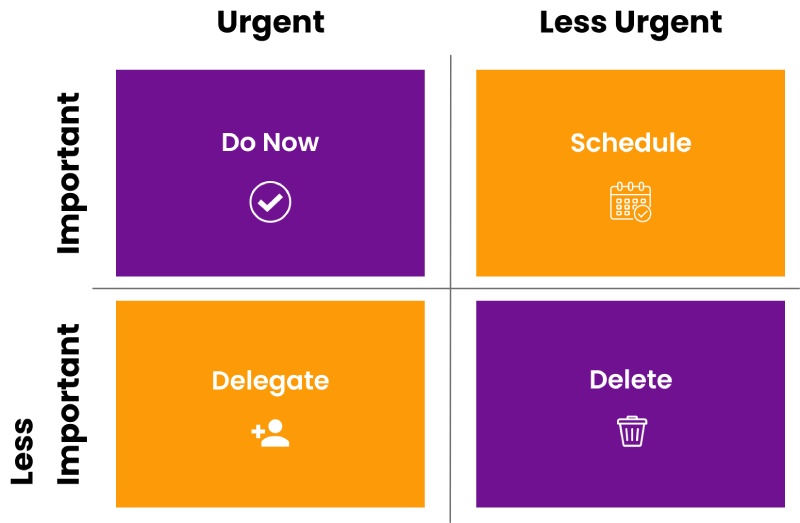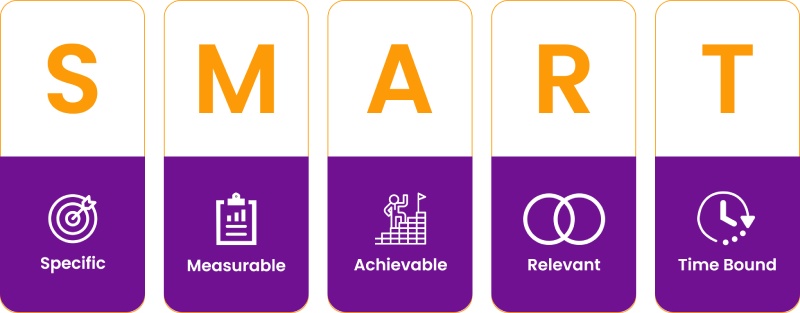Are you stressed out with many things to do and time constraints? This is especially so when time appears to be running away from you. But what if you could take control and make the disorderly world orderly? It is for this reason that with the right time management techniques, you can change your productivity and get your peace of mind back. In this blog, you will discover 20 effective tips that will assist you in taking control of your schedule and your list of tasks. Are you prepared to transform your time management approach? Let’s get started!
What are Time Management Techniques?
Time management techniques are strategies and skills used to make the best use of time. These techniques help you in planning, prioritizing, and executing your tasks in a way that enables you to achieve your goals with less stress and in less time. They range from simple ones like deadlines and to-do lists to more advanced ones like timeboxing and prioritization matrices. Thus, using these techniques, you can manage your workload, achieve work-life balance, and enhance productivity in different spheres of your life.
20 Proven Time Management Techniques
1. Pomodoro Technique: Boost Productivity in Short Bursts
The Pomodoro Technique is a time management technique invented by Francesco Cirillo in the late 1980s. It employs a kitchen timer to divide work into segments, usually of 25 minutes, followed by a break. Each interval is known as a Pomodoro, derived from the Italian word for tomato because Cirillo used a tomato-shaped kitchen timer during his university studies
How it Works:
-
Choose a Task: Choose a task you would like to do.
-
Set a 25-minute timer: This interval is referred to as a “Pomodoro.”
-
Work on the Task: Concentrate on the task until the bell goes.
-
Take a 5-Minute Break: Take a break from work and relax.
-
Repeat: After four Pomodoro’s, take a longer break of 15-30 minutes.
This method ensures that concentration is kept high, reduces fatigue, and increases productivity since work is done in small segments.
2. Eisenhower Matrix: Prioritize Tasks by Urgency
The Eisenhower Matrix or the Urgent-Important Matrix is a time management technique developed by the 34th President of the United States, Dwight D. Eisenhower. This technique assists in sorting out tasks according to their level of significance.
How it Works:
-
Make a Task List: Write down everything you need to get done.
-
Categorize Each Task:
-
Urgent and Important: Tasks requiring immediate attention with significant consequences if left undone.
-
Important But Not Urgent: Tasks that are important for long-term goals but do not require immediate action.
-
Urgent But Not Important: Tasks that need immediate attention but are not crucial for long-term success.
-
Not Urgent and Not Important: Tasks that have little impact on your overall goals and can be postponed or eliminated.
3. Prioritize Tasks:
-
Do First: Concentrate on the activities that are both urgent and important.
-
Schedule: Make time for things that are important but not necessarily urgent.
-
Delegate: Assign urgent but not important tasks to others if possible.
-
Eliminate: Scribble out the tasks that are not both urgent and important in your calendar.

3. Time Blocking: Schedule Tasks for Efficiency
Time Blocking is a time management technique that entails segmenting the day into time slots, each of which is assigned to a particular activity or a set of activities. This technique assists in making sure that one schedules enough time for the activities and minimizes time wastage.
How it Works:
-
List your Tasks: List down all the things that you must do for the day or the week.
-
Divide your Day into Blocks: Schedule chunks of time, which may be 30 minutes to a few hours long, and then allocate each chunk to a particular task or activity.
-
Assign Tasks to Blocks: Assign each task to a particular time slot depending on the task’s priority and the time needed to complete it.
-
Stick to the Schedule: Try to stick to the time blocks as much as possible and do not engage in any other activity other than the one scheduled for that block.
-
Include Breaks and Buffer Time: Have 5-10 minutes of breaks between blocks and additional time for emergencies or other issues.
You can use time blocking apps for a better experience, we have picked out some of the best options available in the market.
4. Pareto Principle: Focus on Key Tasks
The Pareto Principle or the 80/20 rule is a technique that was named by an Italian economist by the name of Vilfredo Pareto. It is based on the Pareto principle which states that 80% of the outcomes are produced by 20% of inputs. The rationale of Pareto analysis is to concentrate on activities most useful in solving problems. By applying the Pareto Principle, you can improve productivity, make better decisions, and achieve your goals more efficiently.
How it Works:
-
List your Problems: List down the challenges or problems that you encounter or the tasks you have at hand.
-
Identify Root Causes: Identify the root causes of each issue or assignment.
-
Assign Scores: Give more points to the problems that have a larger effect.
-
Group by Cause: Categorize the groups with similar issues.
-
Sum Scores: Sum up the scores for each group to determine which group has the highest score and therefore the highest impact.
-
Take Action: Focus first on the group with the highest score.
5. ABCDE Method: Prioritize for Better Results
ABCDE is a time management and prioritization technique created by Brian Tracy, a productivity specialist. This method helps you to sort out the tasks by their importance and urgency and focus on the most important things.
How it Works:
1. List your Tasks: List all the activities that you are required to do.
2. Assign Letters to Each Task:
-
A: Activities that are very crucial and need to be accomplished. These tasks carry serious consequences if not completed.
-
B: Activities that are significant but not as urgent as activities A. These tasks have no serious repercussions if not accomplished.
-
C: Activities that are pleasant to perform but can be done without any negative repercussions if not accomplished.
-
D: Activities that can be done by someone else or outsourced.
-
E: Activities that can be done away with without having a detrimental impact on the organization.
3. Prioritize Within Each Category: If you have more than one A task, then you should label them as A-1, A-2, A-3, and so on.
4. Start With Tasks A: Ensure that tasks A are done first before tasks B and so on to achieve the best results.
6. Getting Things Done (GTD): Streamline Your Workflow
Getting Things Done (GTD) is a productivity method created by David Allen, focusing on organizing tasks, priorities, and projects in a structured way. The core idea behind GTD is to clear your mind by capturing all your tasks and ideas into a reliable system, allowing you to focus better on completing each task without feeling overwhelmed.
How it Works:
-
Capture: Gather all the tasks, ideas, and commitments in a reliable system. This can be a notebook, digital tool, or app.
-
Clarify: Each item is processed to identify what needs to be done. Determine whether it is actionable and, if so, what the precise subsequent action is.
-
Organize: Sort tasks into lists or categories including “Next Actions,” “Projects,” and “Waiting For”. Add contexts like “Work” or “Home” for improved organization.
-
Reflect: Make it a habit to go through your lists and make necessary changes as and when they are due. This involves checking through the schedule at least once a week to make sure that all the items in the schedule are up to date and relevant to the goals.
-
Engage: Select tasks to engage in based on the current context, time available, and energy level. Concentrate on the accomplishment of activities according to the priority and environment.
7. Eat That Frog: Tackle Tough Tasks First
Eat That Frog is a time management technique popularized by Brian Tracy. The idea is based on a quote from Mark Twain: “If it’s your job to eat a frog, it’s best to do it first thing in the morning”. And if you eat two frogs, it’s best to eat the biggest first. In this context, the “frog” represents your most challenging and important task.
How it Works:
-
Identify your “Frog”: Identify the critical and challenging activity that you must do.
-
Tackle it First: This task should be done before any other task for the day is initiated.
-
Stay Focused: Ensure that one gives undivided attention to the task and does not get distracted in the process.
-
Move on to Other Tasks: After the “frog” is done, go on with the other activities.
The Eat That Frog technique helps to eliminate procrastination,improve efficiency, and feel accomplished at the beginning of the day. It assists you in time management and makes sure that you face your most important tasks squarely.
8. SMART Goals: Set Clear Objectives
A SMART Goal is a goal-setting tool that aims to assist you in setting measurable goals. SMART is an acronym for expanding the five characteristics of a good objective, including Specific, Measurable, Achievable, Relevant, and Time-bound. This method helps in making sure that the goals set are clear and realistic within a given period.
How it Works:
-
Specific: Define your goal clearly and precisely. Answer the questions of who, what, where, why, and which.
-
Measurable: Make sure your goal has criteria to gauge progress. This enables you to monitor your advancement and stay motivated.
-
Achievable: Set a goal that is realistic and attainable, considering your resources and constraints.
-
Relevant: Confirm that the goal aligns with your larger objectives and is valuable.
-
Time-bound: Set a deadline for your goal to create a sense of urgency and prompt action.

9. Zen to Done (ZTD): Simplify Your Routine
Zen to Done (ZTD) is a time management strategy developed by Leo Babauta to declutter your life and improve your habits. It borrows the best practices from other time management methods like the GTD and the Zen approach to productivity to offer a practical and efficient way of organizing one’s time.
How it Works:
-
Collect: Gather all the work, plans, and obligations in one list.
-
Process: Items collected should be reviewed periodically and then determine the course of action.
-
Plan: Prioritize your work by making a daily list of 1-3 critical activities that should be accomplished.
-
Do: Approach work in tasks and do not get distracted until all the tasks are done.
-
Simple Trust System: Keep it simple when it comes to the tools and methods of managing tasks and notes, do not overcomplicate things.
-
Organize: Maintain cleanliness and order in your working environment and the items that you use.
-
Review: Check your goals, activities, and behaviors frequently to ensure that you are on the right track and make corrections if needed.
-
Simplify: Always strive to make your tasks, routines, and life easier so that you can avoid stress and work more effectively.
-
Routines: Establish and sustain basic daily habits that are beneficial to your efficiency and health.
-
Find Your Passion: Concentrate on activities that are significant and enjoyable to you.
10. Kanban System: Visualize Your Work
The Kanban System is a visual system of managing work initially developed for manufacturing but is now used in software development and personal organization. Kanban is a system created by Toyota engineer Taiichi Ohno in the late 1940s that allows you to visualize your work, make workflow smoother, and become more efficient.
How it Works:
-
Visualize Workflow: Design a Kanban board with columns that will represent the various steps of the workflow, for instance, “To Do”, “In Progress”, and “Done”.
-
Use Cards: Scribe the tasks on cards or sticky notes and then put them in the right column of the board. Every card corresponds to a particular work or a task to be done.
-
Limit Work in Progress (WIP): Limit the number of tasks that can be placed in each column, especially the ‘In Progress’ column, to avoid overworking and instead focus on the tasks at hand.
-
Move Cards: When you are working on a particular task, physically transfer the card from one column to the other depending on the status of the task.
-
Continuous Improvement: Review the board and the workflow frequently to determine where the processes are getting stuck and how to improve them.
11. MITs (Most Important Tasks): Focus on Priorities
MITs (Most Important Tasks) is a time management technique that prioritizes your daily tasks. This method assists you in making sure that you accomplish the most important tasks first, thus increasing efficiency in the use of time.
How it Works:
-
Identify MITs: Before the beginning of each day, choose 1-3 activities that are the most significant and will contribute to achieving the goals.
-
Prioritize: These should be your most important tasks and ensure that you do them before doing other activities.
-
Plan Your Day: Set aside specific time slots for working on your MITs so that they are given adequate time and focus.
-
Focus: Work on one MIT at a time, avoid multitasking, and keep interference to the minimum until the task is done.
-
Review: At the end of the day, look back and check whether you accomplished your MITs. This reflection should be used to write MITs for the next day.
12. ALPEN Method: Plan Your Day Effectively
The ALPEN Method is a time management technique that has been devised by Lothar J. Seiwert, a German productivity expert. This method offers a framework for organizing your day and thus can be used to enhance efficiency and time management.
How it Works:
-
A – Activities: Write down all the things that you have to do for the day. This can be work-related activities and other engagements that one must attend to.
-
L – Length of Time: Determine the time that will be needed for each activity. This will help plan and set realistic time estimates for each task to avoid underestimations.
-
P – Prioritize: Rank the tasks according to their priority level. Determine which of the tasks are urgent and which of them can be done later or by someone else.
-
E – Eliminate: Remove or outsource activities that are not critical or do not impact your objectives. Concentrate on those tasks that are most beneficial.
-
N – Next Steps: Explain the steps that must be taken to complete each task. Organize the activities and their order so that you can see the direction towards the goal.
13. Timeboxing: Allocate Fixed Time Intervals
Timeboxing is a time management method where you set a certain amount of time for a particular task or project. The use of time limits like 30 minutes or an hour to work means that you set a specific time for work, and this increases focus and reduces procrastination. In this timebox, you focus on the task at hand and do not allow yourself to be distracted in any way to achieve the best results.
When the time is up, you stop working, even if the work is not done. This approach ensures that there are frequent interruptions and ensures that the workload is evenly spread. Timeboxing creates pressure, helps manage time, and ensures that activities are accomplished in the best way possible.
Read more about the Working and Benefits of Timeboxing
14. Rapid Planning Method (RPM): Speed Up Success
Rapid Planning Method (RPM) is a time management strategy that was created by Tony Robbins and is all about getting things done as fast as possible. RPM is more focused on clear and efficient plans and actions to achieve goals and improve overall performance.
How it Works:
-
Results: Start with the identification of the desired performance indicators, which are the specific results or outcomes to be attained. Be specific on how success will be defined for each of the goals.
-
Purpose: It is important to know and relate to the reason or the drive behind each goal. This assists in the aspect of motivation and commitment.
-
Detailed Action Plan: Develop a detailed action plan that will show the specific activities that will be taken to achieve the intended outcomes. Divide the plan into sub-tasks and assign time frames for each of them.
-
Prioritize Actions: Concentrate on the activities that will help you achieve your objectives in the shortest time possible. Do not let yourself be overwhelmed by minor issues.
-
Review and Adjust: It is important to check your progress and modify your plan sometimes. Be adaptable to make adjustments that enhance your way to the goal.
15. The 2-Minute Rule: Handle Quick Tasks Now
The 2-Minute Rule is one of the time management methods used in the GTD method developed by David Allen. It is intended to assist you in dealing with small tasks and avoid the accumulation of such tasks.
How it Works:
If a task can be done in 2 minutes or
less, do it right away. This
includes responding to a short
message, a short phone call, or
organizing a small item.
By
tackling tasks that take 2 minutes
or less immediately, you prevent
them from piling up and cluttering
your to-do list. This approach helps
maintain momentum, streamlines your
workflow, and reduces the mental
load of managing numerous small
tasks, ultimately boosting
productivity.
16. Time Tracking: Monitor Your Productivity
Time Tracking is a time management tool that helps you document how you spend your time during the day. It is a way to find out where time is spent, and what patterns can be observed, and thus, improve efficiency.
How it Works:
-
Record Your Time: Record how much time you spend on various activities using a time-tracking tool or application like Time Champ.
-
Categorize Activities: Arrange your activities into work, meetings, breaks, and personal to have a clear view of what you are doing.
-
Analyze Data: Review the data to identify how time is spent and look for opportunities where time could be more effectively spent.
-
Adjust and Optimize: Use the insights from the data to change the schedule, identify which tasks should be done first, and get rid of unnecessary tasks.
17. Pickle Jar Theory: Prioritize and Schedule
Pickle Jar Theory, which is explained by Stephen R. Covey in his book “The 7 Habits of Highly Effective People”, is one of the best examples of how tasks should be prioritized and scheduled. This theory uses an analogy of a jar filled with large and small rocks, sand, and water to explain the concept of time management.
How it Works:
-
Start with Big Rocks: The ‘big rocks’ should be the most important tasks or goals that need to be accomplished and should be scheduled first. These represent high-priority tasks that have the most significant impact.
-
Add Smaller Rocks: Then, incorporate the other tasks that are not as important (the “small rocks”) to the big rocks. These are important but not as urgent or as significant as the previous ones.
-
Fill with Sand: Insert additional minor, regular assignments or bureaucratic work (the “sand”) to complete the rest of the space. These are usually small chores that can be done alongside other activities of importance to you.
-
Pour in Water: Last of all, state any other activities that can be accomplished if there is still time left (the “water”). This represents flexibility in your schedule for unexpected or less urgent items.
18. Parkinson’s Law: Set Time Limits
Parkinson’s Law is a time management principle formulated by Cyril Northcote Parkinson, which states that “work expands to fill the time available for its completion.” In other words, the more time you allocate to a task, the more time it will take to complete, even if it could be done more quickly.
How it works:
-
Set Clear Deadlines: Define specific time frames for the tasks to be accomplished. This way, you set a deadline for yourself, and this will make you work harder since you will be working under time constraints.
-
Break Tasks into Smaller Chunks: Break down the big tasks into smaller tasks with time frames that are manageable. There is less tendency to delay the work, and it is easier to track its progress.
-
Avoid Over-allocation: One should not be tempted to set very flexible timelines. However, it is recommended that one should spend only the time that is necessary to complete the job, and not get carried away by time expansion.
-
Monitor and Adjust: Pay attention to how strictly you adhere to the schedule and make the necessary corrections. This helps you in the improvement of time management skills and the productivity of tasks.
19. Biological Prime Time: Use Your Peak Productivity Hours
Biological Prime Time is a term used by Dr. Jim Loehr, a productivity specialist and author. In his work on peak performance and time management, Loehr explained how the structuring of tasks about the natural cycles of the individual would enhance performance and efficiency. He has done a lot of work on biological rhythms and their impact on work productivity and has helped in the timing of work concerning biological rhythms.
How it Works:
-
Identify Peak Hours: Observe the level of energy during the day so that you can determine the time of the day when you are most active. These are the biological highs of your day.
-
Schedule Important Tasks: These are the best times of the day to do your most challenging or crucial work. This is because the demanding work is synchronized with the high energy levels in a day hence improving productivity and efficiency.
-
Allocate Downtime: Schedule your work in a way that during your low-energy moments, you will be doing routine or easy tasks. In this way, you can reserve your most productive hours for tasks that require more energy and time.
-
Adjust as Needed: Take some time and go through your energy patterns and possibly adjust your schedule. Lifestyle, health, or work changes may shift the biological prime time.
20. Bullet Journaling: Stay Organized
Bullet Journaling is an effective organizational system created by Ryder Carroll. It is a planner, to-do list, and diary all in one flexible system that is intended to assist you in staying on top of things and organizing your work.
How it Works:
-
Set Up Your Journal: First, it is necessary to make an index at the beginning of the journal to record the contents. Divide the journal into daily, monthly, and future journals according to your requirements.
-
Use Symbols: Use dots for tasks, circles for events, and dashes for notes to sort and rank your entries. This assists you in easily categorizing and dealing with various forms of information.
-
Track and Plan: Record tasks, events, and notes daily and monthly. Check and modify the lists sometimes to monitor the progress and make necessary changes.
-
Customize and Reflect: Add some flair to your bullet journal by incorporating designs like habit trackers, goal sheets, or motivational quotes. It should be used to look back at what has been done and forward to what is yet to be done.
Conclusion
By using these 20-time management techniques in your daily practice, you can control your tasks, prioritize them, and achieve your goals. These are the strategies you should embrace to transform how you handle time and live a more efficient, effective, and successful life.
Boost your productivity today!
Try these time management techniques and explore more at Time Champ.
Learn more time management techniquesFrequently Asked Questions
It enhances efficiency since it assists in time management by enabling one to focus on the most important tasks, avoid time-wasting activities, and effectively allocate time. This results in more effective work sessions, higher completion of tasks, and less stress.
To select the most effective time management strategies, evaluate your work and time characteristics, objectives, and schedules. Try out strategies such as time boxing, the Pomodoro technique, or the ABC method to determine what is most effective.
Some of the issues that people face is time wastage due to delay, distractions, taking up too many tasks and inability to determine which task to do first. Knowing these barriers can assist you in avoiding them in the future and discovering ways of overcoming them.
Time management strategies work towards the accomplishment of long-term objectives by sub dividing them, prioritizing them and minimizing procrastination. Techniques such as goal setting, time management and check-ins guarantee steady work is being done.





